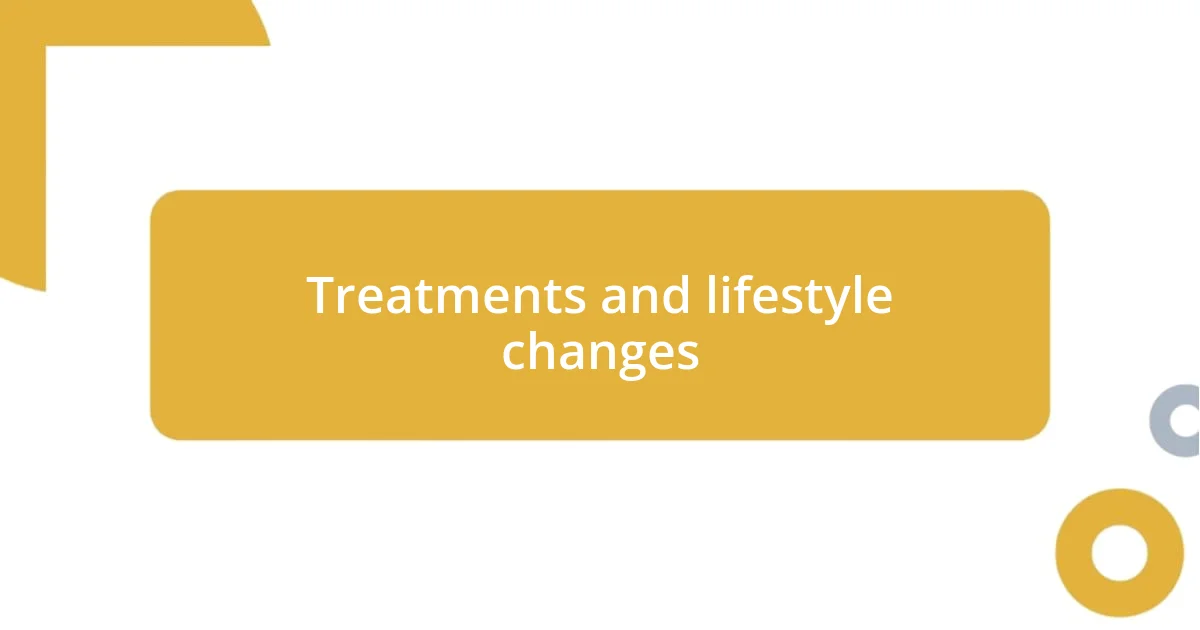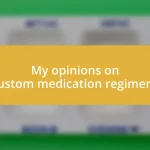Key takeaways:
- Sickle cell disease is a genetic condition that causes severe pain crises and fatigue, impacting both physical and emotional well-being.
- Building a support network and engaging in community advocacy are crucial in managing the challenges of living with sickle cell disease.
- Implementing effective coping strategies, such as mindfulness, journaling, and creative outlets, plays a vital role in maintaining emotional health amidst the struggles of the condition.

Understanding sickle cell disease
Sickle cell disease is a genetic condition that affects the hemoglobin in red blood cells, causing them to form a crescent or “sickle” shape. I remember the first time I learned about it; I was both fascinated and terrified by how something as simple as a change in a single gene could lead to so many challenges. It made me wonder—how can something so small impact our lives so profoundly?
Living with sickle cell disease means dealing with unpredictable pain episodes, often referred to as “crises.” I recall a particularly painful episode, feeling like I was being blindsided by a freight train. It’s hard to articulate the mix of desperation and exhaustion that accompanies these moments, and I often find myself asking, “Why does this have to happen?” Understanding the biological underpinnings of sickle cell can be crucial in navigating these crises, but the emotional landscape can feel just as tumultuous.
Moreover, sickle cell disease is more than just a medical condition; it carries a cultural weight, especially in communities where it is prevalent. I often find myself part of conversations where I share my experiences—the laughter, the tears, and everything in between. It prompts me to think about how awareness and education can help not only patients but also loved ones to understand this complex disease better. How much more could we achieve by working together through our shared stories?

My early symptoms and diagnosis
In the early days of my journey with sickle cell disease, I remember the confusion that accompanied my first symptoms. It started with fatigue that lingered like a cloud over my day-to-day activities. I wanted to keep up with my friends, but simple tasks often drained me—was I just being lazy, or was something medically wrong? Reflecting back, I realize that fatigue is often overlooked, but it was a significant signal that my body was struggling.
As my symptoms progressed, the intense pain came knocking. I had always been active; the idea of enduring sudden pain felt like an unwelcome intruder disrupting my life. Once, while playing a game with friends, I was hit by a wave of pain that left me gasping for breath. It was at that moment I learned about crisis—those horrifying episodes of pain that seem to come out of nowhere. It was during a visit to my doctor after this episode that I received my diagnosis, but I often wonder—what if I hadn’t recognized those early signs?
These experiences, though difficult, were pivotal in shaping my understanding of sickle cell disease. It was a tough realization that I would have to manage this condition for life, but it also opened avenues for support and education within my community. I vividly remember sitting in the doctor’s office, the gravity of the diagnosis sinking in. It marked the beginning of a journey filled with resilience and a deeper appreciation for my health and the people around me.
| Symptom | Description |
|---|---|
| Fatigue | Constant tiredness that made daily activities feel overwhelming. |
| Pain Crises | Unexpected episodes of intense pain, often requiring medical attention. |

Managing daily challenges
Managing daily challenges with sickle cell disease feels like navigating a maze, one with unexpected twists and turns. Every day, I grapple with fatigue that sneaks up on me, often requiring me to set limits on my activities. I’ve learned that taking it slow is essential, even if it means missing out on plans or letting friends down. The guilt can be real, but I remind myself that my health comes first.
Here are some strategies I’ve adopted to tackle daily challenges:
- Rest breaks: Taking short rests throughout the day helps manage fatigue levels.
- Hydration: Staying well-hydrated is crucial; I always carry a water bottle.
- Planning light days: I structure my week to include lighter tasks, which allows me to conserve energy.
- Pain management: I keep track of my pain levels and medication, ensuring I don’t fall behind in managing my symptoms.
- Support network: I surround myself with friends and family who understand my condition, easing the emotional burden.
Each of these practices contributes to my daily well-being and fosters a sense of control over my life despite the unpredictability of sickle cell disease. Balancing self-care with social interactions can be challenging, and I find it essential to communicate openly about my limitations. This way, my loved ones can be supportive rather than disappointed.

Finding support and community
Finding support and community has been vital to my journey with sickle cell disease. I vividly remember the first time I attended a support group—it felt both daunting and comforting. Meeting others who shared similar struggles was like finding a safe haven. I was astonished by how much we could relate to each other’s experiences. We exchanged stories, and suddenly, the burden felt lighter.
Over time, I’ve connected with online forums and social media groups dedicated to sickle cell awareness. These platforms have become invaluable resources for me. I can ask questions and share my daily victories, no matter how small. Some days, it’s a simple triumph of managing pain or staying hydrated, and it’s refreshing to hear, “I get it,” when I share those moments. Isn’t it incredible how understanding from others can make such a difference?
I also treasure the friendships I’ve built with fellow warriors. We celebrate life’s milestones together, providing encouragement on especially challenging days. Has there ever been a moment when someone else’s support felt like a lifeline? For me, those connections not only remind me that I’m not alone but also inspire hope. It’s a community where vulnerability is met with empathy, and in that space, I have found strength.

Treatments and lifestyle changes
Adopting various treatments and lifestyle changes has been crucial in my battle with sickle cell disease. I vividly recall when my doctor first introduced me to hydroxyurea, a medication that helps reduce the frequency of pain crises. At first, I was skeptical—could a pill really make that much of a difference? But after a few months, I noticed a significant reduction in my hospital visits, which was both a relief and a newfound hope.
In addition to medication, I realized that my daily habits play a pivotal role in managing this condition. I’ve developed a routine that focuses on a balanced diet rich in fruits, vegetables, and whole grains. It may sound simple, but nourishing my body is an act of self-love that empowers me. Have you ever considered how what you eat can influence your overall well-being? For me, it’s a game-changer—I sometimes think of food as my first line of defense against fatigue and pain.
Regular check-ups with my healthcare team have also been essential. I make it a point to schedule visits every three months, which allows me to stay on top of my health status and adjust my treatment plan as needed. The peace of mind that comes from having an open dialogue with my doctors is invaluable. How often do we overlook the importance of these conversations? I firmly believe that being proactive and informed can make all the difference, so I encourage others to advocate for their health just as fiercely.

Coping strategies for emotional health
One of the most effective coping strategies I’ve found for emotional health is mindfulness. I remember the first time I tried meditation—it felt awkward sitting in silence with my thoughts racing. But gradually, I learned to focus on my breath, letting go of the stress built up from managing my condition. It’s a reminder that I can take a moment for myself, even when everything else feels overwhelming. Have you ever paused to breathe deeply in the middle of a hectic day? For me, that small act can transform my mood entirely.
Another powerful strategy has been journaling. Each time I pick up my pen, it feels like I’m releasing pent-up emotions onto the page. I often write about my pain experiences, but I also capture moments of joy and gratitude. Reflecting on these positive aspects can shift my mindset when I’m feeling down. Have you ever considered how writing can be a form of therapy? There’s something cathartic about expressing those thoughts, making my struggles feel less isolating.
Lastly, I’ve discovered the importance of creative outlets. Whether it’s painting, writing poetry, or even dancing in my living room, indulging in creativity can be incredibly freeing. I recall a night when I lost track of time while painting, completely absorbed in the colors and strokes. It was like my worries faded away, replaced by a sense of achievement and joy. Creativity allows me to express emotions that I can’t always put into words. What activities bring you joy? Finding those passions is crucial for nurturing emotional well-being amidst the challenges of sickle cell disease.

Inspirational stories and advocacy ways
One story that deeply inspires me is that of a childhood friend who also lives with sickle cell disease. Despite the challenges, she organized community fundraisers to raise awareness and support for others facing similar battles. One event, in particular, stands out: we hosted a local run that attracted hundreds of participants. Seeing everyone come together, united for a cause, made me realize the power of community advocacy. Have you ever seen how a collective effort can spark hope? It’s a beautiful reminder that even small actions can lead to significant change.
In my journey, I’ve also discovered the importance of storytelling as a form of advocacy. When I share my experiences, whether in conversations or on social media, I feel a mix of vulnerability and empowerment. I can remember one post that resonated deeply with my followers—talking about the unpredictability of pain crises and how it affects daily life. The messages of support I received were overwhelming. It made me wonder, how often do we underestimate the impact of sharing our stories? I believe that by opening up, we not only empower ourselves but inspire others to find their voice and seek the necessary support.
Moreover, I have actively participated in advocacy groups that focus on sickle cell awareness. One unforgettable experience was attending a national conference where we spent days discussing research, treatments, and personal stories. Connecting with other patients and advocates filled me with a renewed sense of purpose. I found it energizing to brainstorm ways to promote better healthcare access for the sickle cell community. It raises an essential question: how can we collectively push for the changes we need? Engaging in these spaces reaffirms my commitment to making a difference, and it encourages me to keep fighting for our voices to be heard.














